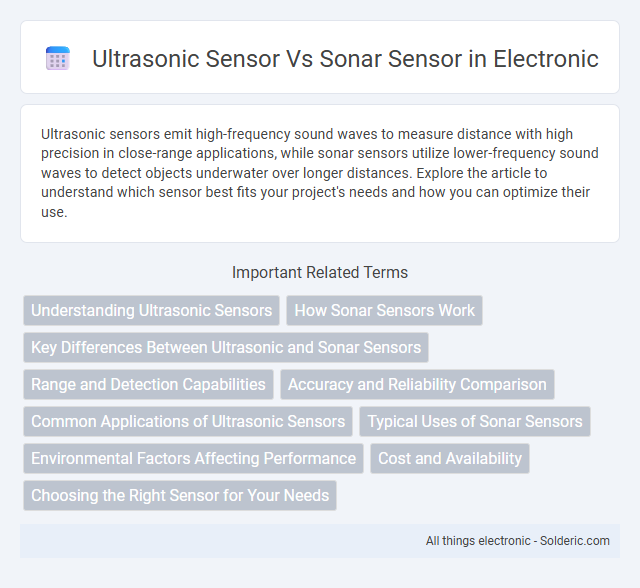Ultrasonic sensors emit high-frequency sound waves to measure distance with high precision in close-range applications, while sonar sensors utilize lower-frequency sound waves to detect objects underwater over longer distances. Explore the article to understand which sensor best fits your project's needs and how you can optimize their use.
Comparison Table
| Feature | Ultrasonic Sensor | Sonar Sensor |
|---|---|---|
| Operating Principle | Emits ultrasonic waves and measures echo time | Uses sound waves underwater, measures echo return |
| Frequency Range | 20 kHz to 40 kHz (typically) | 1 kHz to 100 kHz, varies by application |
| Medium | Air | Water |
| Range | Up to a few meters (e.g., 2-5 m) | Up to several kilometers |
| Applications | Obstacle detection, distance measurement in robotics | Underwater navigation, fish finding, depth measurement |
| Accuracy | High (millimeter to centimeter level) | Moderate to high, depends on signal processing |
| Signal Type | Ultrasound (high frequency sound) | Sonar pulse (acoustic wave) |
| Cost | Low to moderate | Moderate to high |
| Environmental Constraints | Affected by temperature, humidity, air turbulence | Affected by water salinity, temperature, pressure |
Understanding Ultrasonic Sensors
Ultrasonic sensors use high-frequency sound waves above human hearing to detect objects and measure distance by calculating the time it takes for the echo to return. You can rely on ultrasonic sensors for precise and non-contact measurements in applications like robotics, automotive parking assistance, and industrial automation. Their ability to operate in various environments, including low visibility and dusty conditions, makes them highly versatile compared to sonar sensors, which are typically used underwater.
How Sonar Sensors Work
Sonar sensors emit sound pulses underwater and measure the time it takes for the echoes to return after bouncing off objects, enabling precise distance calculation based on sound velocity in water. These sensors utilize piezoelectric transducers to generate and detect high-frequency acoustic signals, which provide detailed imaging or object detection in aquatic environments. The accuracy of sonar sensors depends on factors such as sound absorption, reflection properties of materials, and environmental conditions like temperature and salinity.
Key Differences Between Ultrasonic and Sonar Sensors
Ultrasonic sensors use high-frequency sound waves above human hearing range, typically between 20 kHz and 40 kHz, for precise distance measurement in industrial automation and robotics. Sonar sensors operate at lower frequency ranges, often between 1 kHz and 15 kHz, and are primarily designed for underwater navigation and object detection in marine environments. The main differences lie in their operating frequency, application domain, and medium suitability--ultrasonic sensors excel in air and controlled environments, while sonar sensors are optimized for use in water.
Range and Detection Capabilities
Ultrasonic sensors typically have a shorter effective range, usually up to 4-10 meters, making them ideal for precise object detection and distance measurement in close proximity applications. Sonar sensors can detect objects over longer distances, often exceeding 100 meters, by emitting sound waves that travel through water or air, providing better performance in underwater or large-area detection scenarios. Your choice should consider the required detection range and environmental conditions to optimize sensor performance.
Accuracy and Reliability Comparison
Ultrasonic sensors typically offer higher accuracy than sonar sensors due to their shorter wavelength and faster signal processing, making them ideal for precise distance measurements in close-range applications. Sonar sensors, while less accurate in pinpointing exact distances, provide greater reliability over longer distances and in environments with varying temperature and salinity, commonly used in underwater navigation. Your choice should depend on whether you prioritize precise, short-range detection or robust, long-range reliability in challenging conditions.
Common Applications of Ultrasonic Sensors
Ultrasonic sensors are widely used in automotive parking assistance, robotic obstacle detection, and industrial level measurement due to their precise distance measurement capabilities. These sensors emit high-frequency sound waves and measure the time it takes for the echo to return, enabling accurate detection of nearby objects. Common applications include proximity sensing in manufacturing automation, liquid level monitoring in tanks, and presence detection in security systems.
Typical Uses of Sonar Sensors
Sonar sensors are typically used in underwater navigation, depth measurement, and marine life detection due to their ability to operate effectively in water by emitting sound pulses and detecting echoes. These sensors are essential in applications like submarine navigation, fish finding, and underwater mapping, where precise distance measurement and object identification are crucial. Sonar technology is also employed in industrial settings for tank level measurement and obstacle avoidance in autonomous underwater vehicles (AUVs).
Environmental Factors Affecting Performance
Ultrasonic sensors experience performance variations influenced by environmental factors such as temperature, humidity, and air pressure, which affect the speed of sound and signal attenuation. Sonar sensors, typically used underwater, face challenges from water salinity, temperature gradients, and turbidity that impact sound wave propagation and accuracy. Both sensor types require calibration to local conditions to maintain optimal detection range and precision.
Cost and Availability
Ultrasonic sensors are generally more cost-effective and widely available due to their common use in consumer electronics, robotics, and automotive applications. Sonar sensors, typically used in more specialized fields like underwater navigation and marine research, tend to be more expensive and less readily accessible. Your choice will often depend on the required precision and environmental conditions, with ultrasonic sensors providing a budget-friendly option for short-range, non-submerged sensing.
Choosing the Right Sensor for Your Needs
Ultrasonic sensors provide precise distance measurements using high-frequency sound waves, ideal for short-range object detection and industrial automation. Sonar sensors operate at lower frequencies, offering greater range capabilities suitable for underwater navigation and large-scale environmental mapping. For choosing the right sensor, consider the application environment, required detection range, and measurement accuracy to ensure optimal performance and reliability.
ultrasonic sensor vs sonar sensor Infographic

 solderic.com
solderic.com